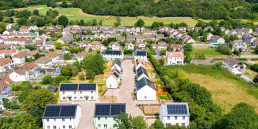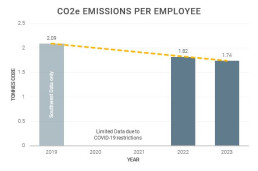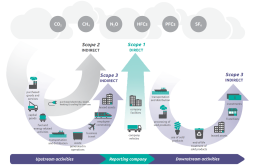Navigating our Net Zero Journey
Lucy Edwards
Lucy is an Architect at BoonBrown with a passion for sustainable, context driven design that responds sensitively to the needs of both users and the environment. As a member of BoonBrown’s Social Value Committee, Lucy is championing carbon footprint awareness and environmental initiatives within the office.
From Impact to Action

As part of BoonBrown’s Social Value Strategy, over the last three years we have been calculating and tracking the Carbon Footprint of our Southwest and London Studios. In 2023, we launched our inaugural Carbon Reduction Plan which outlined our baseline Carbon Footprint along with the carbon reduction initiatives we have implemented and proposed. Since the publication of this plan, we have continued to assess our carbon impact and have recently released an updated Carbon Reduction Plan, now available for viewing on our website here.
As a practice, we are committed to reducing our carbon footprint to achieve Net Zero by 2040. This aligns with the government’s goal to achieve Net Zero emissions in the UK by 2050. The first step in reducing our carbon footprint was to measure our existing impact so that we could identify areas of improvement to reduce our carbon emissions where possible. For emissions which cannot practicably be reduced, we will look at offsetting measures to reach our target goal of Net Zero.
2023 Analysis
In 2023, we observed a modest rise in our Carbon Footprint compared to 2022. While our Scope 2 emissions decreased, there was a slight increase in Scope 3 emissions. This may be partly attributed to the return to regular work and travel practices following the impacts of COVID-19. Additionally, our staff numbers grew from an average of 44 in 2022 to 48 in 2023, which likely contributed to the rise in Scope 3 emissions related to employee commuting.
However, when evaluating BoonBrown’s carbon footprint on a per-employee basis, we observed a decrease from 1.82 tonnes of CO2e in 2022 to 1.74 tonnes of CO2e per employee in 2023. This represents a reduction of approximately 4.5% and continues the trend observed when considering available 2019 data.

Measuring our carbon footprint continues to highlight some interesting findings and statistics, helping to raise awareness of our environmental impact, both collectively as a business and individually through our own day-to-day habits. It also gives weight to the environmental procedures we implement as part of our ISO14001 accreditation.
Read on for a reminder of how we calculate our Carbon Footprint.
Scope 1, 2 & 3 Emissions
There are three ‘Scopes’ which make up our Carbon Footprint calculations, as defined by the Greenhouse Gas Protocol (GHG Protocol) established in 1998:
- Scope 1 covers all direct emissions from sources controlled by an organisation, such as burning fuel in company vehicles, refrigerants, and burning gas in boilers.
- Scope 2 includes indirect greenhouse gas emissions from purchased energy, such as electricity, heating, cooling, and steam.
- Scope 3 covers all remaining indirect greenhouse gas emissions from activities, from sources not owned or controlled by an organisation.
Scope 1 and 2 emissions are generally easy to quantify and record. However, Scope 3 emissions are much harder to measure despite typically accounting for 65% – 95% of an organisation’s total Carbon Footprint. Measuring Scope 3 emissions requires extensive assessment of the supply chain, including both upstream and downstream activities, and often relies heavily on estimates and third-party data.

BoonBrown Carbon Footprint
Our Carbon Footprint is calculated in tonnes of CO2e, or Carbon Dioxide Equivalent. This is a metric measure used to compare emissions of different greenhouse gases based on their global warming potential.
At BoonBrown, our Scope 3 emissions account for approximately 86% of our total Carbon Footprint and are broken down into the following categories:
- Employee Commuting
Calculated based on miles travelled, by transport and fuel type.
- Business Travel
Calculated in the same way as Employee Commuting.
- Business Accommodation
Based on number of nights spent in hotel accommodation.
- Waste and Recycling
Calculated based on total weight of items recycled or sent to landfill, which is recorded as part of our ISO14001 processes.
- Water Usage
Calculated using total water consumption in m3.
- Employees Working from Home
Based on average number of days per week spent working from home.
We used the Small Business Carbon Calculator created by Climate Impact Partners to convert our collected data into tonnes of CO2e.
Our total Carbon Footprint for 2022 was calculated at 80.11 tonnes CO2e, equal to approximately 20 elephants! In 2023 this increased slightly to 83.58 tonnes CO2e. However, when calculated as an average per employee, we saw a reduction from 1.82 tonnes CO2e, to 1.74 tonnes CO2e – a reduction of 4.5%. A full breakdown of our calculations and the emissions attributable to each of the above categories is available in our Carbon Reduction Plan on our website here.
What have we learnt?
This exercise continues to be an enlightening process and allows us to learn more about the theory behind carbon footprint calculation as well as better understanding the environmental impact of our practices and individual actions. Sharing the findings with our teams in London and Yeovil has given weight to the environmental procedures we implement as part of our ISO14001 accreditation, encouraging staff to adopt new ways of working to reduce our carbon footprint.
In 2022, much of the data for our London Studio was calculated based on averages in the Southwest office. Over 2023, we increased our data collection in both studios which has improved the accuracy of our calculations.
Carbon Reduction Initiatives
Our Carbon Reduction Plan outlines both our implemented and proposed carbon reduction initiatives in detail. Below are some examples of initiatives at an individual level that all employees are implementing in their day-to-day working practices:
- Encouraged staff to switch to ‘green’ search engines, such as Ecosia, which uses profits from advertising to plant trees across the globe.
- Removed individual desk bins, to encourage proper recycling of waste.
- Turning off equipment when not in use, including lights, printers, PCs overnight and monitors when not at your desk.
- Only printing when necessary.
- Encouraged car sharing when commuting or attending remote meetings.
- Improved bike storage in the Southwest Studio to encourage cycling to work.
- Unplugging electrical items when fully charged and switching to reusable batteries where possible.
As a practice working in the construction industry, we are well placed to make positive ‘greener’ choices when designing and delivering our projects, encouraging and assisting clients to incorporate sustainable technologies and reducing the carbon impact of development where possible. As we continue to develop our Net Zero strategy, we plan to actively seek opportunities for further offsetting solutions such as tree planting and habitat creation.